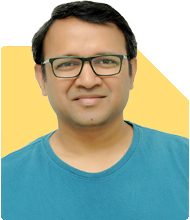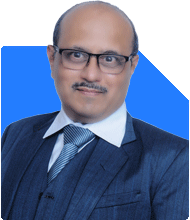Ramalingam Kalirajan |10894 Answers |Ask -Follow
Mutual Funds, Financial Planning Expert - Answered on Jun 18, 2024
He has an MBA in finance from the University of Madras and is a certified financial planner.
He is the director and chief financial planner at Holistic Investment, a Chennai-based firm that offers financial planning and wealth management advice.... more

Sir, I am 38 years old and married and currently have no children or loan. I get a monthly income of Rs 75000/- out if which Rs 30000/-goes into monthly mutual fund sips. My monthly expenses are Rs 30000/-. I also transfer excess cash in an emergency fund when possible. I Invest Rs 50000/- each per year in NPS and PPF respectively and i have a mediclaim cover of Rs 10 Lakhs.I have 20 more years untill retirement. I would like to build a retirement corpus of Rs 2 crores. Kindly guide me as to how to go about it. Also is it recommended to open fixed deposits and if so then about how much worth should i open the same?
Current Financial Overview
Income and Expenses
Monthly Income: Rs 75,000
Monthly SIP Investment: Rs 30,000
Monthly Expenses: Rs 30,000
Surplus for Emergency Fund: Rs 15,000 (when available)
Annual NPS Contribution: Rs 50,000
Annual PPF Contribution: Rs 50,000
Existing Coverage and Investments
Mediclaim Cover: Rs 10 Lakhs
Emergency Fund: Accumulated over time
Time Until Retirement: 20 years
Assessing and Optimizing Your Strategy
Mutual Fund SIPs
Investing Rs 30,000 per month in mutual fund SIPs is commendable. This disciplined approach will benefit from rupee cost averaging and compound growth over time.
Advantages of SIPs:
Regular Investment: Ensures consistent contributions irrespective of market conditions.
Rupee Cost Averaging: Buys more units when prices are low and fewer when prices are high, averaging the cost.
Compounding: Returns reinvested grow exponentially over time.
Recommendation: Continue your current SIPs. Periodically review the performance and diversify across equity, debt, and hybrid funds to balance risk and returns.
National Pension System (NPS)
The NPS is a good choice for long-term retirement planning. Your annual contribution of Rs 50,000 benefits from tax deductions under Section 80C and 80CCD.
Advantages of NPS:
Tax Benefits: Reduces taxable income, providing immediate tax savings.
Retirement Corpus: Builds a substantial corpus with market-linked growth.
Annuity Option: Ensures a regular pension post-retirement.
Recommendation: Continue your NPS contributions. Consider increasing the amount gradually to maximize the retirement corpus and tax benefits.
Public Provident Fund (PPF)
PPF is a safe, long-term investment with assured returns and tax benefits. Your annual contribution of Rs 50,000 to PPF is a prudent choice.
Advantages of PPF:
Safety: Government-backed, providing guaranteed returns.
Tax Benefits: Contributions and interest earned are tax-free under Section 80C.
Long-Term Growth: Suitable for retirement planning due to the 15-year lock-in period.
Recommendation: Continue your annual PPF contributions. It ensures a risk-free portion of your retirement corpus.
Emergency Fund
Having an emergency fund is essential for financial stability. It should cover at least six months of living expenses to manage unforeseen events without liquidating investments.
Recommendation: Maintain and gradually increase your emergency fund to the desired level. Allocate the Rs 15,000 monthly surplus when possible to build this fund.
Building a Rs 2 Crore Retirement Corpus
Calculating the Required Monthly Investment
To build a retirement corpus of Rs 2 crores in 20 years, let's assume an average annual return of 10% from your diversified portfolio (a mix of equity and debt).
Steps to Achieve the Goal:
Evaluate Current Contributions: Calculate the future value of your existing SIPs, NPS, and PPF contributions.
Adjust Investments: Determine if additional monthly investments are needed to meet the target.
Review and Rebalance: Periodically review and adjust the portfolio to stay on track.
Example:
Current SIPs: Rs 30,000/month
NPS Contribution: Rs 50,000/year
PPF Contribution: Rs 50,000/year
Assuming a 10% annual return, calculate the future value of these investments over 20 years.
Importance of Diversification
Equity Mutual Funds
Equity mutual funds offer high growth potential but come with higher risk. Diversifying across large-cap, mid-cap, and small-cap funds can balance the risk.
Recommendation: Allocate a portion of your SIPs to equity mutual funds. Diversify across different types to capture growth while managing risk.
Debt Mutual Funds
Debt mutual funds provide stability and lower risk compared to equity funds. They are ideal for balancing the overall portfolio.
Recommendation: Include debt mutual funds in your SIP portfolio. They offer stable returns and act as a cushion during market volatility.
Balanced or Hybrid Funds
Balanced or hybrid funds invest in a mix of equity and debt instruments, providing growth potential with reduced risk.
Recommendation: Consider balanced funds to maintain a diversified portfolio with a balanced risk-return profile.
Fixed Deposits: A Conservative Approach
Fixed deposits (FDs) offer guaranteed returns and safety but generally lower returns compared to mutual funds. They are suitable for short-term goals and as part of an emergency fund.
Advantages of FDs:
Safety: Principal is secure with assured returns.
Liquidity: Can be easily liquidated if needed.
Predictable Returns: Ideal for short-term financial goals.
Recommendation: Allocate a portion of your emergency fund or short-term savings to FDs. Avoid over-reliance on FDs for long-term growth due to lower returns.
Tax Efficiency
Tax-Saving Instruments
Investing in tax-saving instruments like ELSS (Equity Linked Savings Scheme) can optimize tax benefits and contribute to wealth creation.
Advantages of ELSS:
Tax Deductions: Eligible for deductions under Section 80C.
Short Lock-In Period: Only a three-year lock-in compared to PPF.
Growth Potential: Equity exposure provides high growth potential.
Recommendation: Consider ELSS for tax-saving purposes and long-term growth. It complements your existing tax-saving strategies.
Monitoring and Rebalancing
Regularly monitoring and rebalancing your portfolio ensures it aligns with your financial goals and risk tolerance. Market conditions change, and so do your financial needs.
Recommendation: Review your portfolio at least annually. Rebalance if necessary to maintain the desired asset allocation and optimize returns.
Final Insights
Your current financial strategy is robust and well-structured. Investing Rs 30,000 monthly in SIPs, Rs 50,000 annually in NPS, and Rs 50,000 annually in PPF reflects a disciplined approach. To build a retirement corpus of Rs 2 crores in 20 years, consider the following steps:
Continue Current Investments: Maintain your SIPs, NPS, and PPF contributions. They form a solid foundation for your retirement corpus.
Diversify Portfolio: Include equity, debt, and balanced funds in your SIPs to balance risk and maximize returns.
Build Emergency Fund: Ensure your emergency fund covers at least six months of living expenses. Allocate the monthly surplus towards this fund.
Consider Tax-Saving Instruments: ELSS can provide additional tax benefits and growth potential.
Monitor and Rebalance: Regularly review and adjust your portfolio to stay aligned with your goals.
Fixed deposits can be part of your emergency fund or short-term savings but avoid relying heavily on them for long-term growth. By following these recommendations, you are on the right path to achieving your retirement goal of Rs 2 crores.
Best Regards,
K. Ramalingam, MBA, CFP,
Chief Financial Planner,
www.holisticinvestment.in
You may like to see similar questions and answers below
Sanjeev Govila | Answer |Ask -Follow
Financial Planner - Answered on Aug 06, 2023
Ramalingam Kalirajan |10894 Answers |Ask -Follow
Mutual Funds, Financial Planning Expert - Answered on Jul 25, 2024
Milind Vadjikar | Answer |Ask -Follow
Insurance, Stocks, MF, PF Expert - Answered on Nov 17, 2024
Sunil Lala | Answer |Ask -Follow
Financial Planner - Answered on Jul 23, 2025
Reetika Sharma |425 Answers |Ask -Follow
Financial Planner, MF and Insurance Expert - Answered on Sep 19, 2025
Patrick Dsouza |1429 Answers |Ask -Follow
CAT, XAT, CMAT, CET Expert - Answered on Dec 16, 2025
Nayagam P P |10858 Answers |Ask -Follow
Career Counsellor - Answered on Dec 16, 2025
Nayagam P P |10858 Answers |Ask -Follow
Career Counsellor - Answered on Dec 16, 2025
Samraat Jadhav |2510 Answers |Ask -Follow
Stock Market Expert - Answered on Dec 16, 2025
Samraat Jadhav |2510 Answers |Ask -Follow
Stock Market Expert - Answered on Dec 16, 2025
Nayagam P P |10858 Answers |Ask -Follow
Career Counsellor - Answered on Dec 16, 2025
Nayagam P P |10858 Answers |Ask -Follow
Career Counsellor - Answered on Dec 16, 2025
Ramalingam Kalirajan |10894 Answers |Ask -Follow
Mutual Funds, Financial Planning Expert - Answered on Dec 16, 2025
Nitin Narkhede |113 Answers |Ask -Follow
MF, PF Expert - Answered on Dec 15, 2025
Nitin Narkhede |113 Answers |Ask -Follow
MF, PF Expert - Answered on Dec 15, 2025















.jpg)













